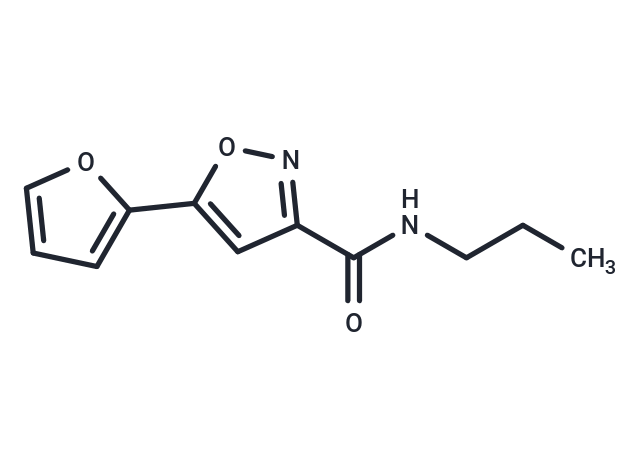Shopping Cart
- Remove All
 Your shopping cart is currently empty
Your shopping cart is currently empty

5-(2-furyl)-N-propylisoxazole-3-carboxamide is a compound used as a molecular structural unit and is thought to be a modulator of NMDA receptors, and has been shown to be protective against glutamate-induced excitotoxicity and oxidative stress in neuronal cells. It has also been found to have anti-inflammatory activity, making it a potential therapeutic agent for diseases such as Alzheimer's disease and Parkinson's disease.

| Pack Size | Price | Availability | Quantity |
|---|---|---|---|
| 2 mg | $30 | In Stock | |
| 5 mg | $45 | In Stock | |
| 10 mg | $67 | In Stock | |
| 25 mg | $115 | In Stock | |
| 50 mg | $173 | In Stock | |
| 100 mg | $260 | In Stock | |
| 200 mg | $379 | In Stock | |
| 1 mL x 10 mM (in DMSO) | $47 | In Stock |
| Description | 5-(2-furyl)-N-propylisoxazole-3-carboxamide is a compound used as a molecular structural unit and is thought to be a modulator of NMDA receptors, and has been shown to be protective against glutamate-induced excitotoxicity and oxidative stress in neuronal cells. It has also been found to have anti-inflammatory activity, making it a potential therapeutic agent for diseases such as Alzheimer's disease and Parkinson's disease. |
| Molecular Weight | 220.22 |
| Formula | C11H12N2O3 |
| Cas No. | 907989-92-8 |
| Smiles | C(NCCC)(=O)C=1C=C(ON1)C2=CC=CO2 |
| Relative Density. | 1.178 g/cm3 (Predicted) |
| Storage | Powder: -20°C for 3 years | In solvent: -80°C for 1 year | Shipping with blue ice. | |||||||||||||||||||||||||||||||||||
| Solubility Information | DMSO: 50 mg/mL (227.05 mM), Sonication is recommended. | |||||||||||||||||||||||||||||||||||
Solution Preparation Table | ||||||||||||||||||||||||||||||||||||
DMSO
| ||||||||||||||||||||||||||||||||||||

Copyright © 2015-2025 TargetMol Chemicals Inc. All Rights Reserved.